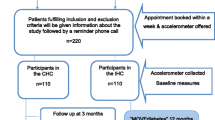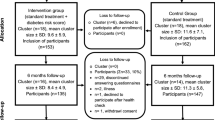Abstract
Aim
This study aimed to develop and validate the Thai physical activity questionnaire (Thai-PAQ) for Thai people at risk for type 2 diabetes (T2D).
Subjects and methods
After development and validation of the questionnaire, 95 people at risk for T2D were recruited. The Thai-PAQ was developed based on the International-PAQ. The Thai-PAQ was evaluated by three experts to ensure content validity. The at-risk people were interviewed using the Thai-PAQ for the previous 7 days’ activities. Spearman’s correlation was used to compare the accelerometer and Thai-PAQ for concurrent validity. Interclass correlation was used to evaluate the reliability of the Thai-PAQ separated by 3 days. Chi-square test was used to represent significant differences (p < 0.05) in the proportion of participants meeting the current physical activity guidelines.
Results
The content validity of the Thai-PAQ was 0.91. The total physical activity from the Thai-PAQ (MET-min week−1), which included the part-time occupation domain and excluded the part-time occupation domain, was significantly correlated with the total physical activity (counts week−1) according to the ActiGraph accelerometer (r = 0.57 and 0.54, p < 0.01, respectively). The 3-day test-retest reliability of the total physical activity of the developed PAQ was 0.86 (p < 0.05) when including the part-time occupation domain and was 0.85 (p < 0.05) when excluding the part-time occupation domain.
Conclusions
The study showed that that concurrent validity had high correlation compared with the ActiGraph accelerometer. Reliability was also acceptable as high reliability. The Thai-PAQ is considered useful for communities as well as a means to ultimately promote physical activity in communities.

Similar content being viewed by others
References
Aekplakorn W et al (2006) A risk score for predicting incident diabetes in the Thai population. Diabetes Care 29:1872–1877
Aekplakorn W et al (2011) Prevalence and management of diabetes and metabolic risk factors in Thai adults: the Thai National Health Examination Survey IV, 2009. Diabetes Care 34:1980–1985
Ainsworth BE et al (2000) Compendium of physical activities: an update of activity codes and MET intensities. Med Sci Sports Exerc 32:S498–S504
Armstrong T, Bull F (2006) Development of the World Health Organization global physical activity questionnaire (GPAQ). J Public Health 14:66–70
Bauman A et al (2009) The international prevalence study on physical activity: results from 20 countries. Int J Behav Nutr Phys Act 6:21
Berthouze SE, Minaire PM, Chatard JC, Boutet C, Castells J, Lacour JR (1993) A new tool for evaluating energy expenditure: the “QAPSE” development and validation. Med Sci Sports Exerc 25:1405–1414
Boon RM, Hamlin MJ, Steel GD, Ross JJ (2010) Validation of the New Zealand physical activity questionnaire (NZPAQ-LF) and the international physical activity questionnaire (IPAQ-LF) with accelerometry. Br J Sports Med 44(10):741–746
Centers for Disease Control and Prevention (2011) Strategies to prevent obesity and other chronic diseases: the CDC guide to strategies to increase physical activity in the community. Retrieved from https://www.cdc.gov/obesity/downloads/PA_2011_WEB.pdf
Cohen J (1988) Statistical power analysis for the behavioral sciences, 2nd edn. Lawrence Earlbaum Associates, New Jersey
Craig CL et al (2003) International physical activity questionnaire: 12-country reliability and validity. Med Sci Sports Exerc 35:1381–1395
Deng HB, Macfarlane DJ, Thomas GN, Lao XQ, Jiang CQ, Cheng KK, Lam TH (2008) Reliability and validity of the IPAQ-Chinese: the Guangzhou biobank cohort study. Med Sci Sports Exerc 40:303–307
Diabetes Prevention Program Research Group (2002) Reduction in the incidence of type 2 diabetes with lifestyle intervention or metformin. N Engl J Med 2002:393–403
Dinger MK, Behrens TK, Han JL (2006) Validity and reliability of the international physical activity questionnaire in college students. Am J Health Educ 37:337–343
Freedson PS, Miller K (2000) Objective monitoring of physical activity using motion sensors and heart rate. Res Q Exerc Sport 71:21–29
Garber CE et al (2011) Quantity and quality of exercise for developing and maintaining cardiorespiratory, musculoskeletal, and neuromotor fitness in apparently healthy adults: guidance for prescribing exercise. Med Sci Sports Exerc 43:1334–1359
Hendelman D, Miller K, Baggett C, Debold E, Freedson P (2000) Validity of accelerometry for the assessment of moderate intensity physical activity in the field. Med Sci Sports Exerc 32:S442–S449
Howley ET (2001) Type of activity: resistance, aerobic and leisure versus occupational physical activity. Med Sci Sports Exerc 33:S364–S369
International Physical Activity Questionnaire (2005) International physical activity questionnaire. www.ipaq.ki.se. Accessed 15 May 2018
Ishikawa-Takata K et al (2008) Physical activity level in healthy free-living Japanese estimated by doubly labelled water method and international physical activity questionnaire. Eur J Clin Nutr 62:885
Laporte RE, Montoye HJ, Caspersen CJ (1985) Assessment of physical activity in epidemiologic research: problems and prospects. Public Health Rep 100:131
Manley AF (1996) Physical activity and health: a report of the surgeon general. DIANE Publishing, Collingdale
Mayor S (2007) International diabetes federation consensus on prevention of type 2 diabetes. Int J Clin Pract 61:1773–1775
Miller DJ, Freedson PS, Kline GM (1994) Comparison of activity levels using the Caltrac accelerometer and five questionnaires. Med Sci Sports Exerc 26:376–382
Montoye HJ (1996) Measuring physical activity and energy expenditure. Human Kinetics, Champaign
Physical Activity Guidelines Advisory Committee (2008) Physical activity guidelines advisory committee report. Retrieved from US Department of Health and Human Services, Washington DC. https://health.gov/paguidelines/report/pdf/committeereport.pdf
Plasqui G, Westerterp KR (2007) Physical activity assessment with accelerometers: an evaluation against doubly labeled water. Obesity 15:2371–2379
Pols MA, Peeters PH, Ocké MC, Bueno-de-Mesquita HB, Slimani N, Kemper HC, Collette HJ (1997) Relative validity and repeatability of a new questionnaire on physical activity. Prev Med 26:37–43
Pongurgsorn C (2002) A questionnaire for assessment of physical activity in Thailand. Doctoral disertation, University of Illinois at Urbana-Champaign
Reis JP, Dubose KD, Ainsworth BE, Macera CA, Yore MM (2005) Reliability and validity of the occupational physical activity questionnaire. Med Sci Sports Exerc 37:2075–2083
Sallis JF (2010) Measuring physical activity: practical approaches for program evaluation in native American communities. J Public Health Manag Pract 16:404
Shai I, Jiang R, Manson JE, Stampfer MJ, Willett WC, Colditz GA, Hu FB (2006) Ethnicity, obesity, and risk of type 2 diabetes in women. Diabetes Care 29:1585–1590
Shephard RJ (2003) Limits to the measurement of habitual physical activity by questionnaires. Br J Sports Med 37:197–206
Singh A, Purohit B (2011) Evaluation of global physical activity questionnaire (GPAQ) among healthy and obese health professionals in Central India. Baltic Journal of Health and Physical Activity 3:34
Sranacharoenpong K, Hanning RM (2011) Developing a diabetes prevention education programme for community health-care workers in Thailand: formative findings. Prim Health Care Res Dev 12:357–369
Suzuki I, Kawakami N, Shimizu H (1998) Reliability and validity of a questionnaire for assessment of energy expenditure and physical activity in epidemiological studies. J Epidemiol 8:152–159
van Poppel MN, Chinapaw MJ, Mokkink LB, Van Mechelen W, Terwee CB (2010) Physical activity questionnaires for adults. Sports Med 40:565–600
Visuthipanich V (2008) Development and testing of a physical activity questionnaire among community-dwelling older Thai adults in Bangkok Mahidol University
Vongsvat K (2002) The nutrition and health transition in Thailand. Public Health Nutr 5:183–189
Wattanasit P, Prateepchaikul L, Petpichetchian W, Meininger JC, Kijboonchoo K (2010) Validity and reliability of the modified Thai adolescent’s physical activity questionnaire. Pac Rim Int J Nurs Res 14:79–92
Welk G (2002) Physical activity assessments for health-related research. Human Kinetics, Champaign
WHO (2009) Global health risks: mortality and burden of disease attributable to selected major risks. Retrieved from World Health Organization Publisher, Geneva http://www.who.int/healthinfo/global_burden_disease/GlobalHealthRisks_report_full.pdf
Wild S, Roglic G, Green A, Sicree R, King H (2004) Global prevalence of diabetes: estimates for the year 2000 and projections for 2030. Diabetes Care 27:1047–1053
Acknowledgements
The authors acknowledge the team staff of the health care offices in Chiang Mai Province, Thailand. The authors particularly thank for team staff of The Office of Disease Prevention and Control 10 Chiang Mai Province, Ministry of Public Health, for their facilities and hospitality. The authors thank Ms. Julia Verhaeghe for English language editing.
Funding
This research was supported by the Nestlé Foundation in Switzerland, grant no. 51/201217.
Author information
Authors and Affiliations
Corresponding author
Ethics declarations
Conflict of interest
The authors declare that they have no conflict of interest.
Ethical approval
Ethical consideration of this study was sent for approval by the Chiang Mai Public Health Office Institutional Review Board, Ministry of Public Health, Thailand. All the respondents signed an informed consent form.
Rights and permissions
About this article
Cite this article
Chirdkiatisak, M., Sranacharoenpong, K., Churak, P. et al. Thai diabetes prevention education program: development and validation of the Thai physical activity questionnaire for at-risk people. J Public Health (Berl.) 27, 659–667 (2019). https://doi.org/10.1007/s10389-018-0989-2
Received:
Accepted:
Published:
Issue Date:
DOI: https://doi.org/10.1007/s10389-018-0989-2




